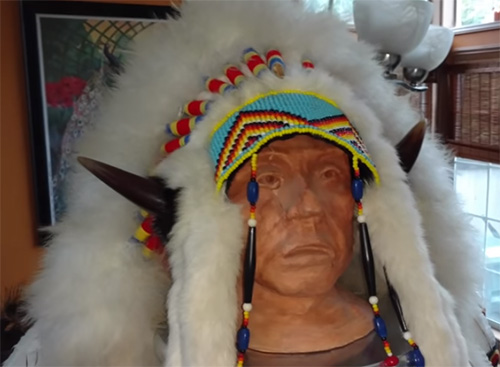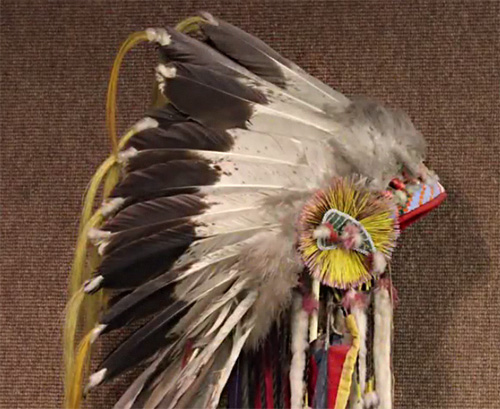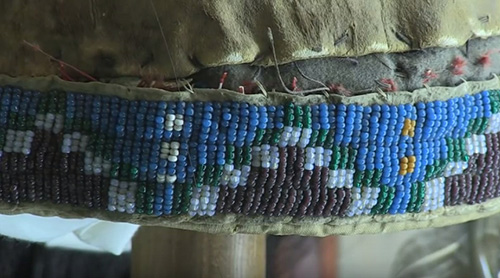 The traditional warbonnet of Native American Indians is a sacred headdress. There is a deep philosophical meaning behind each small element of it that can be surprising or even odd for a European observer. We’d like to try to reveal at least some of the secrets and rituals connected to the Native American headdress.
The traditional warbonnet of Native American Indians is a sacred headdress. There is a deep philosophical meaning behind each small element of it that can be surprising or even odd for a European observer. We’d like to try to reveal at least some of the secrets and rituals connected to the Native American headdress.
Why do they use eagle feathers as a decoration?
For the Native Americans, to receive an eagle feather is one of the highest honors a person can have. The eagle feather represents the passage of wisdom, of honor, and of esteem; and the person accepting an eagle feather has received one of the greatest honors that people can give to show the leadership and spiritual connection. Native Americans believe that when they pray, the eagle takes their prayers to the Great Spirit (in other words, to God).
 Bright horned warbonnet decorated with feathers, fur, and beading
Bright horned warbonnet decorated with feathers, fur, and beading
The eagle feather was always something that was highly esteemed by the locals. The members of the tribe who become the leaders are being given eagle feathers for specific things they have done. In the end of their lives, when they're able to put together that headdress with all those eagle feathers – each one represents some great act or deed that they did and they could tell you the story behind that eagle feather. It shows the whole tribe that each member has an important role and every deed matters.

Ceremonial warbonnet used by a chief of the Blackfeet tribe
The other thing to know is that when a Native American Indian keeps an eagle feather, he keeps it in a sacred manner – an eagle feather must never touch the ground. It does touch the ground only during a special ceremony that locals do. And that ceremony is for a warrior that's fallen. The Native Americans believe that if the eagle feather touches the ground in any other situation, it means that someone in the nation or the tribe will pass. That’s why they must immediately do a ceremony to bring that eagle spirit back to that feather. So, eagle feathers used for a war bonnet are something to be taken very special care of.
Why is it honorable to have real buffalo horns in your horned warbonnet?
In the Yellowstone County Museum, there is a Sioux tribe split-horn buffalo headdress. It was worn by the Warriors to intimidate their enemies in battle. It consists of a band with beaded ornaments (made from glass beads) on the front, two horns (actually, it’s a one buffalo horn that's been split into two), and a bundle of hair that comes off from the top to the back of the headgear.

Vintage beadwork on the band of a Sioux split-horn buffalo headdress
Of course, the horns are intimidating and look pretty devilish but that’s not the important thing about the usage of them. It’s the way of getting the horns that matters.
“Specific types of warriors would be able to wear this headdress. You wouldn't be able just to go out and make your own buffalo horns headdress. You'd have to earn it, whether that be through battles, whether that be through counting coup (if you were the Plains Indians), whether that be through some sort of achievement that you did when you were younger, but everything in the Native American tribe you had to earn”, explains Benjamin Nordlund, Yellowstone County Museum director.

Benjamin Nordlund shows the Sioux split-horn buffalo warbonnet
So, the Native Americans valued the horns and bones (especially, predators’ or human) because the only way to get one is to kill the animal or your enemy. And when the animal is killed, it is being divided among the members of the tribe according to their status and input. Only the best warriors and the leaders got such important piece of the carcass as the horns.
In modern time, we can make artificial horns or other items to decorate our costume, as many as we need or want. But the Native American Indians didn’t use fake horns or feathers, only real, which were rather hard to get.
Lately, many Native American Indians are protesting against white people wearing Indian traditional warbonnets. They feel like their sacred headdresses are being violated because just about anybody can use them. These warbonnets became a very popular part of Halloween costumes, party attires, etc. We won’t discuss here whether white people should wear the warbonnets or not, but one thing is for sure: this headdress is definitely one of the most impressive and spiritual headgears of the world. And the ancient knowledge about the Indian chief’s warbonnets should be kept and transferred to the next generations. This tradition is worth keeping.


